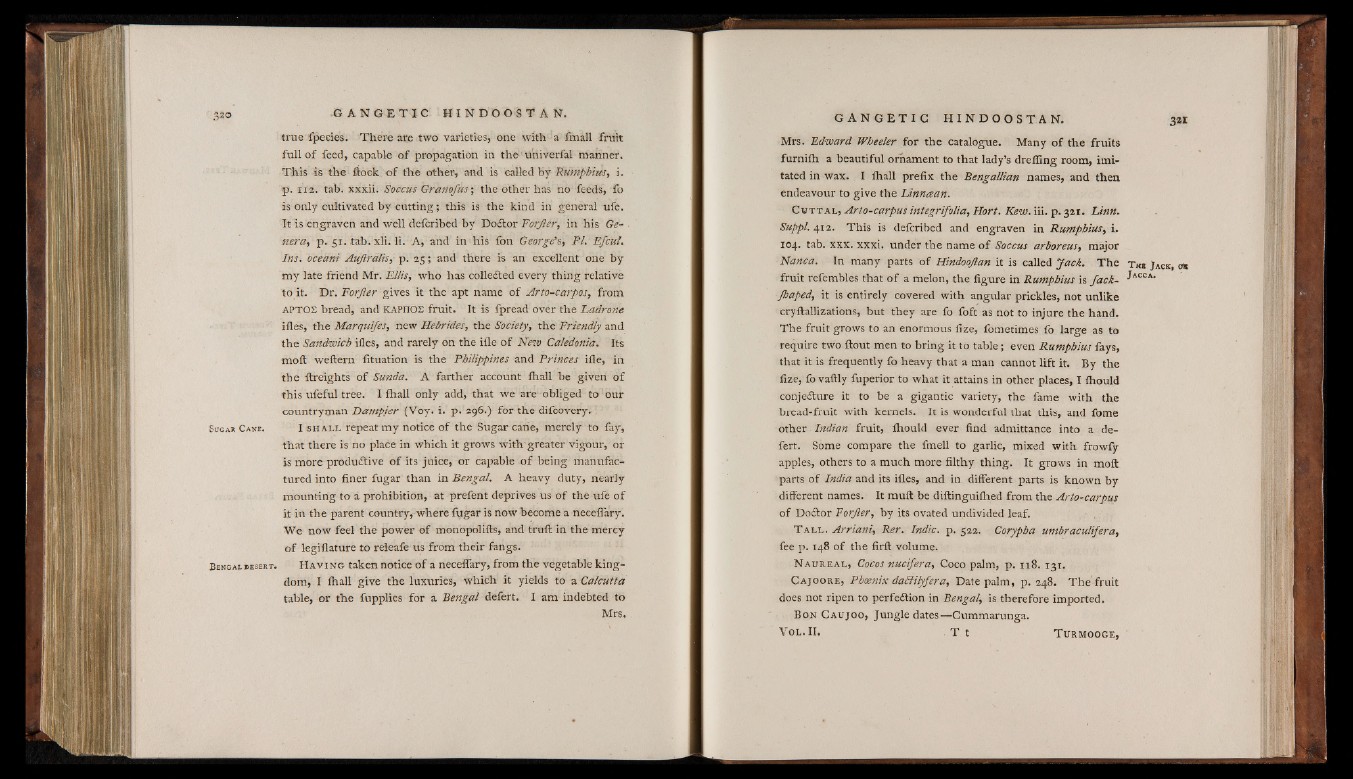
S u g a r C a n e .
B e n g a l » e s e r t .
true fpeeies. There are two varieties, one with a fmall fruit
full of feed, capable of propagation in th e ' univerfal manner.
This is the ftock of the other, and is called by Rump him, i.
p. iia . tab. xxxii. Soccus Granofus', the other has no feeds, fo
is only cultivated by cutting; this is the kind ill general ufe.
It is engraven and well defcribed by DoCtor Forjler, in his Genera,
p. 51. tab. xli. li. A, and in his fon George's, PL EfcuL
Ins. oceani Aujlraiis, p. 25; and there is an excellent one by
my late friend Mr. Ellis, who has collected every thing relative
to it. Dr. Forjler gives it the apt name o f Arto-carpos, from
APTOE bread, and KAPnos fruit. It is fpread over the Padrone
ifles, the Marquifes, new Hebrides, the Society, the Friendly and
the Sandwich ifles, and rarely on the iile of New Caledonia. Its
moil weftern fituation is the Philippines and Princes iile, in
the ftreights of Sunda. A farther account ihall be given of
this ufeful tree. I ihall only add, that we are obliged to our
countryman Dampier (Voy. i. p. 296.) for the difcovery,:
I s h a l l repeat my notice of the Sugar cane, merely to fay,
that there is no place in which it grows with greater vigour, or
is more productive o f its juice, or capable o f being manufactured
into finer fugar than in Bengal. A heavy duty, nearly
mounting to a prohibition, at prefent deprives us o f the ufe of
it in the parent country, where fugar is now become a neeeffary.
We now feel the power of monopolifts, and trail in the mercy
o f legiilature to releaife us from their fangs.
Ha v in g taken notice o f a neeeffary, from the vegetable k ingdom,
I ihall give the luxuries, which it yields to a Calcutta
table, or the fupplies for a Bengal defert. I am indebted to
Mrs.
Mrs. Edward Wheeler for the catalogue. Many of the fruits
furnifh a beautiful ornament to that lady’s drefiing room, imitated
in wax. I ihall prefix the Bengallian names, and then
endeavour to give the Linnaan.
C u t t a l , Arto-carpus integrifolia, Hort. Kew. iii. p. 321. Linn.
Suppl. 41a. This is defcribed and engraven in Rumphius, i.
104. tab. xxx. xxxi. under the name o f Soccus arboreus, major
Nanca. In many parts o f Hindoojlan it is called Jack. The
fruit refembles that o f a melon, the figure in Rumphius is fack-
fhaped, it is entirely covered with angular prickles, not unlike
cryftallizations, but they are fo foft as not to injure the hand.
The fruit grows to an enormous fize, fometimes fo large as to
require two ftout men to bring it to table; even Rumphius fays,
that it is frequently fo heavy that a man cannot lift it. By the
fize, fo vaftly fuperior to what it attains in other places, I ihould
conjecture it to be a gigantic variety, the fame with the
bread-fruit with kernels. It is wonderful that this, and fome
other Indian fruit, ihould ever find admittance into a defert.
Some compare the fmell to garlic, mixed with frowiy
apples, others to a much more filthy thing. It grows in moil
parts of India and its ifles, and in different parts is known by
different names. It mufl be diilinguiihed from the Arto-carpus
o f DoCtor Forjler, by its ovated undivided leaf.
T a l l . Arriani, Rer. Indie, p. 522. Corypha umbraculifera,
fee p. 148 of the firit volume.
N a u r e a l , C ocos n u c i fe r a , Coco palm, p. 118. 131.
C ajoore, Phoenix daBilyfera, Date palm, p. 248. T h e ’fruit
does not ripen to perfection in Bengal, is therefore imported.
Bon C aujoo, Jungle dates— Cummarunga.
T h e J a c k , o k
J a c c a .